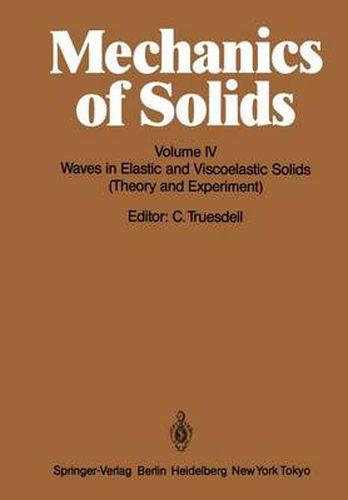Readings Newsletter
Become a Readings Member to make your shopping experience even easier.
Sign in or sign up for free!
You’re not far away from qualifying for FREE standard shipping within Australia
You’ve qualified for FREE standard shipping within Australia
The cart is loading…






This title is printed to order. This book may have been self-published. If so, we cannot guarantee the quality of the content. In the main most books will have gone through the editing process however some may not. We therefore suggest that you be aware of this before ordering this book. If in doubt check either the author or publisher’s details as we are unable to accept any returns unless they are faulty. Please contact us if you have any questions.
Reissue of Encyclopedia of Physics / Handbuch der Physik, Volume VIa The mechanical response of solids was first reduced to an organized science of fairly general scope in the nineteenth century. The theory of small elastic deformations is in the main the creation of CAUCHY, who, correcting and simplifying the work of N AVIER and POISSON, through an astounding application of conjoined scholarship, originality, and labor greatly extended in breadth the shallowest aspects of the treatments of par ticular kinds of bodies by GALILEO, LEIBNIZ, JAMES BERNOULLI, PARENT, DANIEL BER NOULLI, EULER, and COULOMB. Linear elasticity became a branch of mathematics, culti vated wherever there were mathematicians. The magisterial treatise of LOVE in its second edition, 1906 - clear, compact, exhaustive, and learned - stands as the summary of the classical theory. It is one of the great gaslight works that in BOCHNER’S words! either do not have any adequate successor[s] ‘ or, at least, refuse to be super seded … ; and so they have to be reprinted, in ever increasing numbers, for active research and reference , as long as State and Society shall permit men to learn mathe matics by, for, and of men’s minds. Abundant experimentation on solids was done during the same century. Usually the materials arising in nature, with which experiment most justly concerns itself, do not stoop easily to the limitations classical elasticity posits.
$9.00 standard shipping within Australia
FREE standard shipping within Australia for orders over $100.00
Express & International shipping calculated at checkout
This title is printed to order. This book may have been self-published. If so, we cannot guarantee the quality of the content. In the main most books will have gone through the editing process however some may not. We therefore suggest that you be aware of this before ordering this book. If in doubt check either the author or publisher’s details as we are unable to accept any returns unless they are faulty. Please contact us if you have any questions.
Reissue of Encyclopedia of Physics / Handbuch der Physik, Volume VIa The mechanical response of solids was first reduced to an organized science of fairly general scope in the nineteenth century. The theory of small elastic deformations is in the main the creation of CAUCHY, who, correcting and simplifying the work of N AVIER and POISSON, through an astounding application of conjoined scholarship, originality, and labor greatly extended in breadth the shallowest aspects of the treatments of par ticular kinds of bodies by GALILEO, LEIBNIZ, JAMES BERNOULLI, PARENT, DANIEL BER NOULLI, EULER, and COULOMB. Linear elasticity became a branch of mathematics, culti vated wherever there were mathematicians. The magisterial treatise of LOVE in its second edition, 1906 - clear, compact, exhaustive, and learned - stands as the summary of the classical theory. It is one of the great gaslight works that in BOCHNER’S words! either do not have any adequate successor[s] ‘ or, at least, refuse to be super seded … ; and so they have to be reprinted, in ever increasing numbers, for active research and reference , as long as State and Society shall permit men to learn mathe matics by, for, and of men’s minds. Abundant experimentation on solids was done during the same century. Usually the materials arising in nature, with which experiment most justly concerns itself, do not stoop easily to the limitations classical elasticity posits.